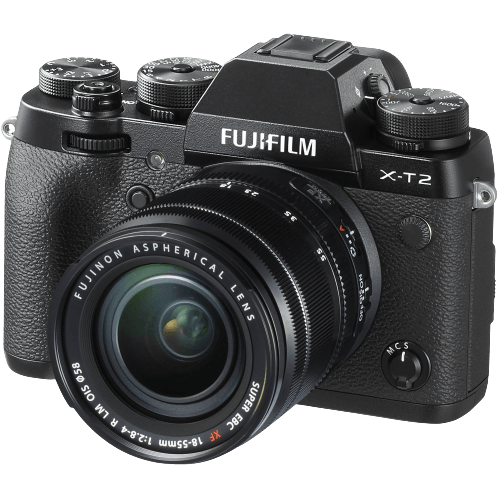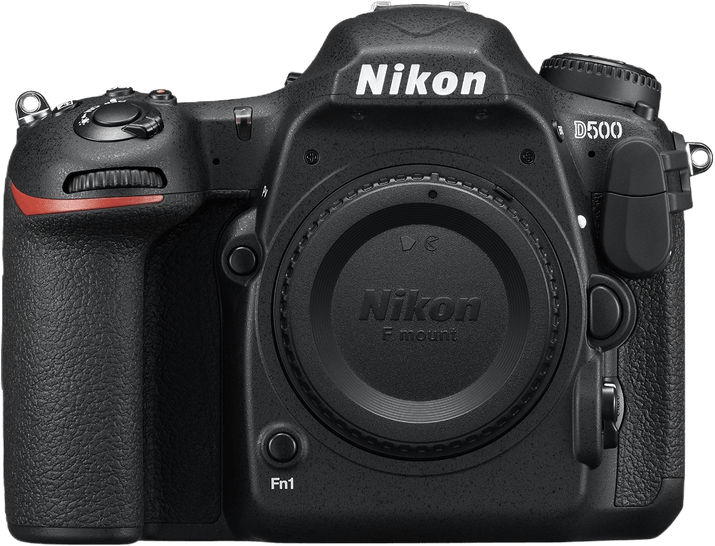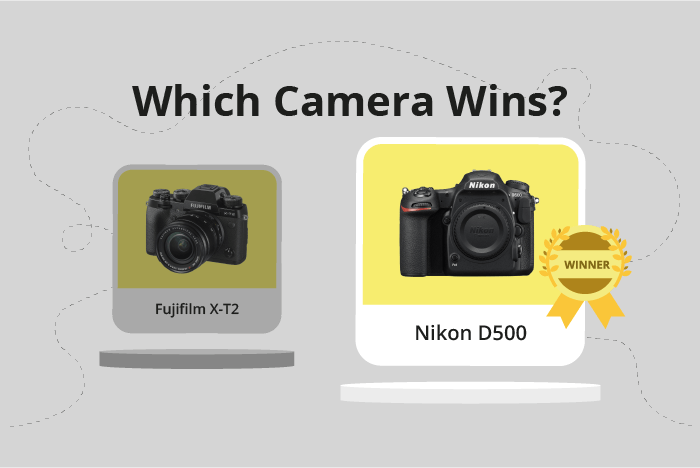Fujifilm X-T2 vs Nikon D500 Comparison
Fujifilm X-T2

Nikon D500

The Nikon D500 outperforms the Fujifilm X-T2 with a score of 75/100 compared to 68/100. Both cameras were released in 2016, with the X-T2 being a mirrorless camera and the D500 a DSLR. They share common specifications, including launch prices of $1599 for the Fujifilm X-T2 and $2000 for the Nikon D500.
The Nikon D500’s higher score reveals its superiority in certain aspects. However, the Fujifilm X-T2 has its advantages, such as being lighter (507g) and smaller (133 x 92 x 49mm) compared to the Nikon D500 (860g and 147 x 115 x 81mm).
Taking these factors into consideration, the Nikon D500 proves to be the better camera, but the Fujifilm X-T2 may appeal to those seeking a lighter and more compact option.
Fujifilm X-T2 vs Nikon D500 Overview and Optics
The Nikon D500 outperforms the Fujifilm X-T2 in optics, scoring 69/100 compared to the X-T2’s 66/100. Both cameras share several specifications, including a CMOS sensor, APS-C sensor size, and no image stabilisation. However, there are notable differences that contribute to the higher score of the Nikon D500.
The Nikon D500 has a DXOMARK sensor score of 84, while the Fujifilm X-T2 does not have a DXOMARK score. This indicates that the D500 has a superior sensor performance. Additionally, the D500 uses the Expeed 5 processor, which is efficient and powerful, enhancing the camera’s overall performance.
On the other hand, the Fujifilm X-T2 boasts a higher megapixel count of 24, compared to the D500’s 20.9 megapixels. This allows the X-T2 to capture more detail in images. Moreover, the X-T2 has a faster shooting speed of 14 frames per second, enabling it to capture fast-moving subjects more effectively than the D500, which has a shooting speed of 10 frames per second.
While both cameras have their advantages, the Nikon D500’s superior sensor performance and efficient processor contribute to its higher optics score. The Fujifilm X-T2, however, excels in megapixel count and shooting speed, making it a strong competitor. Ultimately, the choice between these two cameras depends on the specific needs and preferences of the photographer.
Fujifilm X-T2 vs Nikon D500 Video Performance
The Fujifilm X-T2 outperforms the Nikon D500 in video capabilities, scoring 83 out of 100, while the Nikon D500 scores 70. Both cameras share some common video specifications, such as 4K max video resolution and 3840 x 2160 max video dimensions. Additionally, both cameras have built-in time-lapse functionality.
The Fujifilm X-T2 is superior due to its higher max video frame rate of 60fps, compared to the Nikon D500’s 30fps. This higher frame rate allows for smoother and more detailed video capture, especially in fast-moving scenes or action shots. The X-T2’s ability to shoot at 60fps makes it a better choice for videographers who require high-quality video performance.
On the other hand, the Nikon D500 does not offer any specific advantages in video capabilities over the Fujifilm X-T2. Both cameras have the same max video resolution and dimensions, as well as built-in time-lapse functionality. The lower frame rate of 30fps on the Nikon D500 may be sufficient for some users, but it does not outshine the X-T2’s 60fps frame rate.
Considering the video specifications of both cameras, the Fujifilm X-T2 is the clear winner in terms of video performance. Its higher frame rate of 60fps provides smoother and more detailed video capture, making it an ideal choice for videographers who prioritize video quality. The Nikon D500, while still a capable camera, does not offer any advantages in video capabilities over the X-T2 and falls short with a lower max video frame rate.
Fujifilm X-T2 vs Nikon D500 Features and Benefits
The Nikon D500 outperforms the Fujifilm X-T2 in features with a score of 87/100 compared to the X-T2’s 70/100. Both cameras share some common specifications, such as a flip screen, WIFI, and Bluetooth connectivity. Neither camera has GPS functionality.
The Nikon D500 exceeds the Fujifilm X-T2 in screen size and resolution. The D500 has a 3.2-inch screen with a resolution of 2,359,000 dots, while the X-T2 has a smaller 3-inch screen with a lower resolution of 1,040,000 dots. Additionally, the D500 has a touchscreen, which the X-T2 lacks. This makes the Nikon D500 more user-friendly and provides a better viewing experience on the camera’s screen.
The Fujifilm X-T2, though trailing in features, has its advantages. Its compact size and lighter weight make it more portable than the Nikon D500. However, this advantage does not compensate for the X-T2’s lower feature score.
Based on the feature comparison, the Nikon D500 is a superior camera. Its larger screen, higher resolution, and touchscreen functionality contribute to a better user experience. The Fujifilm X-T2’s compact design is its only advantage, but it does not surpass the D500’s overall quality. Therefore, the Nikon D500 is the better camera in terms of features.
Fujifilm X-T2 vs Nikon D500 Storage and Battery
The Nikon D500 outperforms the Fujifilm X-T2 in storage and battery with a score of 79/100 compared to 68/100. Both cameras share common specifications, such as having two memory card slots and accepting SD, SDHC, and SDXC (UHS-II compatible) cards.
The D500 surpasses the X-T2 in battery life, providing 1240 shots per charge compared to the X-T2’s 340 shots. Additionally, the D500 accepts XQD memory cards, giving users more storage options.
The X-T2, however, offers USB charging, which the D500 lacks. This feature allows for convenient charging on the go.
Taking these factors into account, the Nikon D500 proves superior in battery life and storage options. Meanwhile, the Fujifilm X-T2 offers the advantage of USB charging, providing added flexibility for users.
Alternatives to the Fujifilm X-T2 and Nikon D500
Are you still undecided about which camera is right for you? Have a look at these popular comparisons that feature the Fujifilm X-T2 or the Nikon D500:

